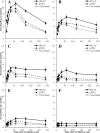Low doses of X-rays induce prolonged and ATM-independent persistence of γH2AX foci in human gingival mesenchymal stem cells
- PMID: 26314960
- PMCID: PMC4694989
- DOI: 10.18632/oncotarget.4739
Low doses of X-rays induce prolonged and ATM-independent persistence of γH2AX foci in human gingival mesenchymal stem cells
Abstract
Diagnostic imaging delivering low doses of radiation often accompany human mesenchymal stem cells (MSCs)-based therapies. However, effects of low dose radiation on MSCs are poorly characterized. Here we examine patterns of phosphorylated histone H2AX (γH2AX) and phospho-S1981 ATM (pATM) foci formation in human gingiva-derived MSCs exposed to X-rays in time-course and dose-response experiments. Both γH2AX and pATM foci accumulated linearly with dose early after irradiation (5-60 min), with a maximum induction observed at 30-60 min (37 ± 3 and 32 ± 3 foci/cell/Gy for γH2AX and pATM, respectively). The number of γH2AX foci produced by intermediate doses (160 and 250 mGy) significantly decreased (40-60%) between 60 and 240 min post-irradiation, indicating rejoining of DNA double-strand breaks. In contrast, γH2AX foci produced by low doses (20-80 mGy) did not change after 60 min. The number of pATM foci between 60 and 240 min decreased down to control values in a dose-independent manner. Similar kinetics was observed for pATM foci co-localized with γH2AX foci. Collectively, our results suggest differential DNA double-strand break signaling and processing in response to low vs. intermediate doses of X-rays in human MSCs. Furthermore, mechanisms governing the prolonged persistence of γH2AX foci in these cells appear to be ATM-independent.
Keywords: DNA double-strand breaks; DNA repair; X-rays; low doses; mesenchymal stem cells.
Conflict of interest statement
The authors declare no conflict of interest.
Figures





Similar articles
-
Formation of γH2AX and pATM Foci in Human Mesenchymal Stem Cells Exposed to Low Dose-Rate Gamma-Radiation.Int J Mol Sci. 2019 May 29;20(11):2645. doi: 10.3390/ijms20112645. Int J Mol Sci. 2019. PMID: 31146367 Free PMC article.
-
Low-Dose Hypersensitive Response for Residual pATM and γH2AX Foci in Normal Fibroblasts of Cancer Patients.Int J Radiat Oncol Biol Phys. 2018 Mar 1;100(3):756-766. doi: 10.1016/j.ijrobp.2017.10.054. Epub 2017 Nov 6. Int J Radiat Oncol Biol Phys. 2018. PMID: 29248168
-
Long-term culture of mesenchymal stem cells impairs ATM-dependent recognition of DNA breaks and increases genetic instability.Stem Cell Res Ther. 2019 Jul 29;10(1):218. doi: 10.1186/s13287-019-1334-6. Stem Cell Res Ther. 2019. PMID: 31358047 Free PMC article.
-
Mechanism of elimination of phosphorylated histone H2AX from chromatin after repair of DNA double-strand breaks.Mutat Res. 2010 Mar 1;685(1-2):54-60. doi: 10.1016/j.mrfmmm.2009.08.001. Epub 2009 Aug 12. Mutat Res. 2010. PMID: 19682466 Review.
-
Does gammaH2AX foci formation depend on the presence of DNA double strand breaks?Cancer Lett. 2005 Nov 18;229(2):171-9. doi: 10.1016/j.canlet.2005.07.016. Epub 2005 Aug 29. Cancer Lett. 2005. PMID: 16129552 Review.
Cited by
-
Extracellular Vesicles Mediate Radiation-Induced Systemic Bystander Signals in the Bone Marrow and Spleen.Front Immunol. 2017 Mar 27;8:347. doi: 10.3389/fimmu.2017.00347. eCollection 2017. Front Immunol. 2017. PMID: 28396668 Free PMC article.
-
Residual γH2AX foci induced by low dose x-ray radiation in bone marrow mesenchymal stem cells do not cause accelerated senescence in the progeny of irradiated cells.Aging (Albany NY). 2017 Nov 21;9(11):2397-2410. doi: 10.18632/aging.101327. Aging (Albany NY). 2017. PMID: 29165316 Free PMC article.
-
Effects of low-dose X-ray medical diagnostics on female gonads: Insights from large animal oocytes and human ovaries as complementary models.PLoS One. 2021 Jun 24;16(6):e0253536. doi: 10.1371/journal.pone.0253536. eCollection 2021. PLoS One. 2021. PMID: 34166427 Free PMC article.
-
DNA damage-associated biomarkers in studying individual sensitivity to low-dose radiation from cardiovascular imaging.Eur Heart J. 2016 Oct 21;37(40):3075-3080. doi: 10.1093/eurheartj/ehw206. Epub 2016 Jun 5. Eur Heart J. 2016. PMID: 27272147 Free PMC article. Review. No abstract available.
-
The response of human mesenchymal stem cells to internal exposure to tritium β-rays.J Radiat Res. 2019 Jul 1;60(4):476-482. doi: 10.1093/jrr/rrz037. J Radiat Res. 2019. PMID: 31165153 Free PMC article.
References
-
- Cipriani P, Ruscitti P, Di Benedetto P, Carubbi F, Liakouli V, Berardicurti O, Ciccia F, Triolo G, Giacomelli R. Mesenchymal stromal cells and rheumatic diseases: new tools from pathogenesis to regenerative therapies. Cytotherapy. 2015;17:832–849. - PubMed
-
- Caplan AI. Mesenchymal stem cells. Journal of orthopaedic research: official publication of the Orthopaedic Research Society. 1991;9:641–650. - PubMed
-
- Hematti P. Mesenchymal stromal cells and fibroblasts: a case of mistaken identity? Cytotherapy. 2012;14:516–521. - PubMed
Publication types
MeSH terms
Substances
LinkOut - more resources
Full Text Sources
Other Literature Sources
Research Materials
Miscellaneous

